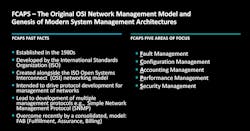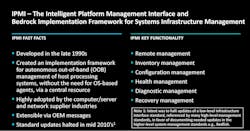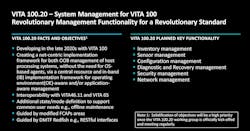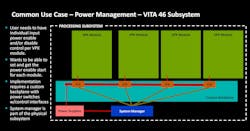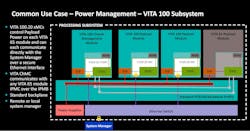Managing Mission-Critical VITA 100 Systems
VITA 100 is a collection of standards from VITA. It’s a follow-on to the successful VITA OpenVPX standards. The VITA 100.20 is one of the VITA standards that targets system management. Daniel Toohey, Fellow and Technologist in the Advanced Concepts Group at Mercury Systems, provided an excellent overview of VITA 100.20 at this year’s VITA Embedded Tech Trends conference (watch the video above).
What is VITA 100.20?
System-management systems have been around a long time. Fault, configuration, accounting, performance, security, otherwise known as FCAPS, is an ISO telecommunications management network model and framework that addresses network management developed in the 1980s (Fig. 1).
Subsequently, the Intelligent Platform Management Interface (IPMI) was developed in the 1990s for out-of-band (OOB) system management (Fig. 2). It’s been used extensively in server management.
VITA 100.20 was started in the late 2020s as part of the VITA 100 project (Fig. 3). It is interoperable with prior VITA management standards that include VITA 46.11 and VITA 65.
VITA 100.20 supports the Object Management Group’s (OMG) Model-based System Engineering standard (MBSE). MBSE uses modeling to support developers through a system’s lifecycle, including system requirements, design, analysis, verification, validation, and system-management activities (Fig. 4).
The Importance of System Management in Rugged Systems
System management based on standards gives developers a way to incorporate system management into their design, providing interoperability between system devices as well as the ability for these to work with compatible software. The standards deliver the needed compatibility between applications and devices.
System power management is an example of a common system-management use case. With VITA 46, the system manager was part of the system, but developers needed to have custom power-management support on each board (Fig. 5).
VITA 65 utilized Intelligent Platform Management Controller (IPMC) software and provided standard support on each board (Fig. 6). A Chassis Management Controller (ChMC) provides a single point of contact for the system manager that’s typically connected via Ethernet. VITA 65, built on the VITA 46.11 IPMI and ChMC definitions, also includes a standard backplane and board interface.
VITA 100.20 uses an architecture similar to VITA 65, using a more advanced ChMC and management controllers (MCs) for VITA 100 modules. It’s backwards compatible, so the ChMC can support a VITA 65 module. The Ethernet connection also uses a secure link.
Compatibility is key to supporting rugged, field replaceable units (FRUs). This requires compatibility at all levels from the backplane, boards, modules, and software. VITA 100.20 offers a broader standard definition, making it easier for designers to select and support a wide range of hardware (Fig. 7).
About the Author
William G. Wong
Senior Content Director - Electronic Design and Microwaves & RF
I am Editor of Electronic Design focusing on embedded, software, and systems. As Senior Content Director, I also manage Microwaves & RF and I work with a great team of editors to provide engineers, programmers, developers and technical managers with interesting and useful articles and videos on a regular basis. Check out our free newsletters to see the latest content.
You can send press releases for new products for possible coverage on the website. I am also interested in receiving contributed articles for publishing on our website. Use our template and send to me along with a signed release form.
Check out my blog, AltEmbedded on Electronic Design, as well as his latest articles on this site that are listed below.
You can visit my social media via these links:
- AltEmbedded on Electronic Design
- Bill Wong on Facebook
- @AltEmbedded on Twitter
- Bill Wong on LinkedIn
I earned a Bachelor of Electrical Engineering at the Georgia Institute of Technology and a Masters in Computer Science from Rutgers University. I still do a bit of programming using everything from C and C++ to Rust and Ada/SPARK. I do a bit of PHP programming for Drupal websites. I have posted a few Drupal modules.
I still get a hand on software and electronic hardware. Some of this can be found on our Kit Close-Up video series. You can also see me on many of our TechXchange Talk videos. I am interested in a range of projects from robotics to artificial intelligence.

Daniel Toohey
Daniel Toohey is a Fellow Chief Technologist within the Advanced Concepts Group at Mercury Systems. He has been involved in open standards development for over 25 years. Dan chaired and authored multiple VPX standards, created the original architecture, taxonomy, and glossary for OpenVPX at its inception and transitioned it into VITA, has served as the working group chair for VITA 46.11 (System Management for VPX) since inception, continues to co-lead System Management subcommittees in SOSA since its inception, and co-leads the VITA 100.20 System Management working group. In addition, Dan serves on the SOSA Steering Committee and VITA Standards Organization (VSO) board of directors.
